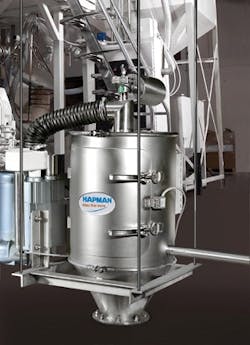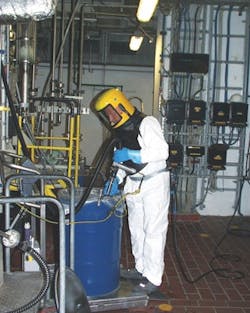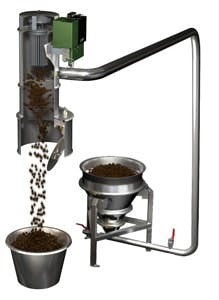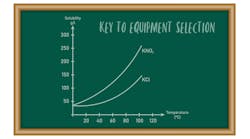Ask a vacuum conveyor vendor what's new and the answer is likely to be both "not much" and "everything." After all, vacuum technology has changed little over the past decade but each conveying project presents a unique combination of processing issues, usually requiring some customization.
"There are not a lot of new things about vacuum conveying, but there are new applications every day," notes Doan Pendleton, vice president of marketing and sales for Vac-U-Max, Belleville, N.J.
"One of our strengths is that we have a standard line of equipment and also a custom metal shop. If you have an application where you have to discharge to a mixing tank next to a wall, we can take our standard vacuum receiver and reengineer it so it fits into that space," he says.
Piab, Hingham, Mass., boasts that its highly modular equipment provides flexibility. "We can customize anything based on a mix-and-match approach," explains Brian Wilson, who handles technical sales and support for the company's Material Handling Group. The firm makes a single vacuum pump housing but can alter vacuum capacity simply by adjusting the number of air ejector cartridges. "If an application changes and they need more capacity, we can swap out components and add air ejector cartridges, filters or a module for fluidization," he says.
"Customization is our forte. We're not trying to shove a single design or approach down a customer's throat," notes Ed Heller, president of Industrial Equipment & Design Co. (IEDCO), Turnersville, N.J.
Customer demands continue to evolve. Chemical manufacturers want new vacuum systems to increase throughput, protect worker health, and improve plant safety and efficiency. Yet, because their staffs are lean and overloaded with projects, they expect a lot more from vendors. Instead of looking for vacuum conveyors and receivers, facility managers want complete systems that they can plug into plants and forget about.
This trend has been apparent for 10 or 15 years, but intensified since the recession in 2008. "Many customers rely on us far more than they had for preventative maintenance and also for advice on what spare parts they need to carry to keep their plant running optimally," says Nick Hayes, president of Volkmann, Hainesport, N.J. Some companies, such as Hapman, Kalamazoo, Mich., also offer formal managed maintenance plans for their equipment.
FILLING A VOID
Plants opt for vacuum systems where screw conveyors, which are simpler and less expensive, simply won't work. "The number one thing people look at first is a screw conveyor," says Steve Grant, Hapman product manager. "But maybe the vertical distance is too high, or you have to work around existing equipment, or maybe you need to go around a couple of bends or through a wall… Or if you're involved in batching operations, it's more ergonomic to put a vacuum wand in a drum and empty it out than have someone carry that drum to the top of a hopper," he adds.
Unlike screw systems, vacuum conveyors can curve around reactors and deliver particles to an upper mezzanine with a 90° bend. While not as low-cost as screw conveyors, they are relatively inexpensive and require little maintenance. Vacuum lines even purge themselves (with a vacuum, of course) when switching between products. They also simplify dust control, because any leak will suck in air rather than blow out powders.
Vacuum conveyors also have disadvantages, notes Joe Morris, vice president of sales and marketing for Cyclonaire, York, Neb. They are limited in length, generally to no more than 100 ft, and usually to moving material to a single point because switching destinations requires a vacuum receiver at each location as well as a complex system of valves.
Also, vacuum conveyors that rely on high airflow can pulverize fragile products. In such lean-phase systems air speed can exceed 1 mile per minute. This is fast enough to turn tablets into fine powders the first time they reach a 90° bend.
Use of lower air speed can solve this problem. Intermediate-phase systems, for example, provide just enough vacuum to entrain some powders while letting others drop to the bottom of the line. As these powders build up, they impede airflow. This increases suction and air speed at that point in the line, pulling the powders forward in gentle waves. The result is smooth and relatively gentle transport.
However, this approach doesn't work well with mixtures of fine and coarse particles. Dense-phase conveying solves this problem by ratcheting down air speeds further. This causes powders to build up until they plug the line. The vacuum eventually pulls the plug of material slowly through the line. "It moves so slowly you can convey very delicate products without damaging them," says Hayes.
BULK BENEFITS
Even the slowest vacuum conveyors can achieve large increases in productivity by enabling companies to switch to more flexible intermediate bulk containers (FIBCs), also known as bulk bags, from smaller packages such as 50-lb bags. The 1-ton bulk bags are simpler to handle and store. In addition, companies often can get substantial discounts for purchasing material in FIBCs.
More importantly, though, use of bulk bags simplifies process automation. Instead of manually handling 50-lb bags, say, to fill a hopper above a mixer, a vacuum line from the bulk bag can charge the material. Adding the vacuum system simplifies process flow and eliminates labor and the risk of injury from lifting.
"You can add sensors and it will automatically dose it, monitor the hopper, and send a message to the control room when it is time to get a new bag. It's cleaner and more convenient," says Morris. "We had people say they wanted to load up a weekend's worth of product. If something goes wrong, the system calls you on the phone. Otherwise, you come back in on Monday," he adds.
Even in low-volume applications, where bulk bags make little sense, vacuum systems can simplify process flow (Figure 1) and reduce the potential for injuries caused by lifting and unloading (Figure 2).
Many companies opt for vacuum systems to save labor, Heller notes. "If they can save a job here or there in terms of cleaning or maintenance, they want to do that, too," he adds.
Vacuum systems are relatively easy to maintain because they contain no moving parts. Over the years, vendors have solved many of the problems that once plagued the systems.
"I've worked in vacuum conveying for 17 years, and I can remember systems that workers had to whack to get product moving," recalls Piab's Wilson. "Now we have much better filtration systems and fluidizers to break up caked powders in hoppers. No one wants to have to babysit their system today."
Piab and other vendors also have made their systems easier to pull apart to service.
"Every aspect of our vacuum pump is modular, from the air shock housing to air ejectors. The average pump lasts seven years before it requires maintenance, and if something breaks or fails, you can replace just that component," notes Wilson. "It is designed so that even a small stature operator can take it apart. The parts are small and easy to lift. The only thing you need a tool for are three hex nuts," he says.
Hapman has made its filters easier to clean by shifting the filter door to the side of the housing from the top, where traditionally it's located. "It's safer because maintenance people don't have to get on top of a silo or hopper and remove the top cover with the filter attached. We can now put our filters right up to the ceiling," notes Grant.
IEDCO's Heller points out that many of these innovations — high reliability, easy maintainability, quick cleaning, and tight material containment — started in the pharmaceutical industry and spread to fine chemical and other manufacturers.
COST SAVINGS
Piab has introduced a less expensive system specifically for non-pharmaceutical manufacturers that don't require the corrosion resistance of Type 316L stainless steel. "It's for companies that make food, neutraceuticals, spices and fine chemicals. Its ability to have a full open bottom valve gives it very high throughput," explains Wilson.
The new piFlow system (Figure 3) costs 40% less than a similar 316L system, he says. Savings stem not just from switching materials but also from use of a more basic control system and the need for less extensive validation. In addition, the system boasts fewer optional features (such as fluidization).
Hapman and some other vendors argue that using electric blowers rather than plant air (from large compressed-air systems) saves money over the long term. "Plant air is very expensive to generate, and vacuum conveyors consume a lot of it. While both systems are similar in price initially, over the long run electric motors are cheaper to run than plant air systems," says Grant.
Hayes disagrees: "Vacuum systems only use plant air when actually conveying material. They do not run continuously. When you are refilling your hopper, you can't stop and start an electrical motor without ruining it, so what do you do? You leave the motor running and purge the air through a bypass system. So you're paying to pump air into atmosphere.
"With a plant air system, I take a 10-lb slug to the hopper, stop, and discharge. When I discharge, I cut the airflow. What that allows us to do is reverse-pulse the filter to clean it out. So I'm cleaning the filters when I'm not pulling a vacuum.
"People say it costs more money for compressed air, but when it stops it costs you nothing. When you're running a motor, you have to run it all the time and that costs money," says Hayes.
IEDCO's Heller also cites benefits of plant air. "IEDCO's mantra is: 'We don't mess around with things that go around… We try and design rotating machinery out of the equation. Compressed-air-driven vacuum pumps have no moving parts and are easier to maintain." However, the company isn't rigid about only using plant air. "So instead of pushing compressed air down our customers' throats, we also provide rotary claw, or bush, pumps. We've actually fallen in love with them. They have very flat vacuum performance and they can pull nearly as much vacuum as a compressed air system… By offering them, we can provide more flexibility in how we configure our lines."
Plant air systems also are much quieter than electric pumps and are intrinsically safe.
Hayes likes to talk about reducing the risk of explosions. He points to the 2008 explosion at an Imperial Sugar refinery, where a spark set off sugar dust that had accumulated in the rafters, killing 14 workers, injuring 40 others, and totaling the facility. (See: "Dust Gets Its Due")
Vacuum systems not only reduce the likelihood of sparks, but also prevent product from leaking into the plant.





